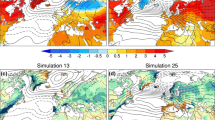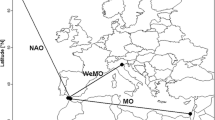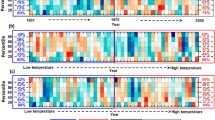Abstract
The study evaluates relationships between the North Atlantic Oscillation (NAO) index and winter temperatures (including indices of extremes) over Europe in an ensemble of transient simulations of current global climate models (GCMs). We focus on identification of areas in which the NAO index is linked to winter temperatures and temperature extremes in simulations of the recent climate (1961–2000), and evaluate how these relationships change in climate change scenarios for the late 21st century (2071–2100). Most GCMs are able to reproduce main features of the observed links. The NAO index is more important for cold than warm extremes, which is also reproduced by the GCMs. However, all GCMs underestimate the magnitude of the NAO influence on cold extremes when averaged over northern and western Europe. For future scenarios, the links between the NAO and temperatures are mostly analogous to those in the recent climate, except for one GCM (CM3) in which the influence of the NAO on temperature almost disappears over whole Europe. This suggests that future scenarios from this particular GCM should be evaluated with caution. The NAO index is found to represent a useful covariate that explains an important fraction of variability of cold extremes in winter, and its incorporation into extreme value models for daily temperatures (and their possible changes under climate change) may improve performance of these models and reliability of estimates of extremes and their uncertainty.
Similar content being viewed by others
References
Barnston A.G. and Livezey R.E., 1987. Classification, seasonality and persistence of low-frequency atmospheric circulation patterns. Mon. Weather Rev., 115, 1083–1126.
Beranová R. and Huth R., 2008. Time variations of the effects of circulation variability modes on European temperature and precipitation in winter. Int. J. Climatol., 28, 139–158.
Brown S.J., Caesar J. and Ferro C.A.T., 2008. Global changes in extreme daily temperature since 1950. J. Geophys. Res., 113, D05115.
Casado M.J. and Pastor M.A., 2012. Use of variability modes to evaluate AR4 climate models over the Euro-Atlantic region. Clim. Dyn., 38, 225–237, DOI 10.1007/s00382-011-1077-2.
Coles S., 2001. An Introduction to Statistical Modeling of Extreme Values. Springer-Verlag, London, U.K.
Gámiz-Fortis S.R., Esteban-Parra M.J., Pozo-Vázquez D. and Castro-Díez Y., 2011. Variability of the monthly European temperature and its association with the Atlantic sea-surface temperature from interannual to multidecadal scales. Int. J. Climatol., 31, 2115–2140.
Guirguis K., Gershunov A., Schwartz R. and Bennett S., 2011. Recent warm and cold daily winter temperature extremes in the Northern Hemisphere. Geophys. Res. Lett., 38, L17701.
Hurrell J.W. and van Loon H., 1997. Decadal variations in climate associated with the North Atlantic Oscillation. Clim. Change, 36, 301–326.
Jacobeit J., Jönsson P., Bärring L., Beck C. and Ekström M., 2001. Zonal indices for Europe 1780-1995 and running correlations with temperature. Clim. Change, 48, 219–241.
Kalnay E., Kanamitsu M., Kistler R., Collins W., Deaven D., Gandin L., Iredell M., Saha S., White G., Woollen J., Zhu Y., Leetmaa A., Reynolds B., Chelliah M., Ebisuzaki W., Higgins W., Janowiak J., Mo K.C., Ropelewski C., Wang J., Jenne R. and Joseph D., 1996. The NCEP/NCAR 40-year reanalyses project. Bull. Am. Meteorol. Soc., 77, 437–471.
Kyselý J., Picek J. and Beranová R., 2010. Estimating extremes in climate change simulations using the peaks-over-threshold method with a non-stationary threshold. Glob. Planet. Change, 72, 55–68.
López-Moreno J.I., Vicente-Serrano S.M., Morán-Tejeda E., Lorenzo-Lacruz J., Kenawy A. and Beniston M., 2011. Effects of the North Atlantic Oscillation (NAO) on combined temperature and precipitation winter modes in the Mediterranean mountains: Observed relationships and projections for the 21st century. Glob. Planet. Change, 77, 62–76.
Meehl G.A., Covey C., Delworth T., Latif M., McAvaney B., Mitchell J. F. B., Stouffer R. J. and Taylor K. E., 2007. The WCRP CMIP3 multi-model dataset: A new era in climate change research. Bull. Am. Meteorol. Soc., 88, 1383–1394.
Osborn T.J., 2004. Simulating the winter North Atlantic Oscillation: the roles of internal variability and greenhouse gas forcing. Clim. Dyn., 22, 605–623.
Papadimas C.D., Bartzokas A., Lolis C. J. and Hatzianastassiou N., 2012. Sea-level pressure-air temperature teleconnections during northern hemisphere winter. Theor. Appl. Climatol., 108, 173–189, DOI: 10.1007/s00704-011-0523-8.
Santos J. and Corte-Real J., 2006. Temperature extremes in Europe and wintertime large-scale atmospheric circulation: HadCM3 future scenarios. Clim. Res., 31, 3–18.
Scaife A.A., Folland C.K., Alexander L.V., Moberg A. and Knight J.R., 2008. European Climate Extremes and the North Atlantic Oscillation. J. Climate, 21, 72–83.
Solomon S., Qin D., Manning M., Chen Z., Marquis M., Averyt K.B., Tignor M. and Miller H.L. (Eds.), 2007. Climate Change 2007 — The Physical Science Basis. Contribution of Working Group I to the IPCC Fourth Assessment Report. Cambridge University Press, Cambridge, U.K.
Stephenson D.B. and Pavan V., 2003. The North Atlantic Oscillation in coupled climate models: a CMIP1 evaluation. Clim. Dyn., 20, 381–399.
Stephenson D.B., Pavan V., Collins M., Junge M.M. and Quadrelli R., 2006. North Atlantic Oscillation response to transient greenhouse gas forcing and the impact on European winter climate: a CMIP2 multi-model assessment. Clim. Dyn., 27, 401–420.
Stoner A.M.K., Hayhoe K. and Wuebbles D.J., 2009. Assessing general circulation model simulations of atmospheric teleconnection patterns. J. Climate, 22, 4348–4372.
Trigo R.M, Osborn T.J. and Corte-Real J., 2002. The North Atlantic Oscillation influence on Europe: Climate impacts and associated physical mechanisms. Climate Res., 20, 9–17.
Walker G.T., and Bliss E.W., 1932. World Weather V. Mem. Roy. Meteor. Soc., 4, No. 36, 53–84.
Wallace J.M. and Gutzler D.S., 1981. Teleconnections in the geopotential height field during the northern Hemisphere winter. Mon. Weather Rev., 109, 784–812.
Wilks D.S., 1995. Statistical Methods in the Atmospheric Sciences: An Introduction. Academic Press, San Diego, New York, Boston, London, Sydney, Tokyo, Toronto, 467 pp.
Author information
Authors and Affiliations
Corresponding author
About this article
Cite this article
Beranová, R., Kyselý, J. Relationships between the North Atlantic Oscillation index and temperatures in Europe in global climate models. Stud Geophys Geod 57, 138–153 (2013). https://doi.org/10.1007/s11200-012-0824-0
Received:
Revised:
Accepted:
Published:
Issue Date:
DOI: https://doi.org/10.1007/s11200-012-0824-0




